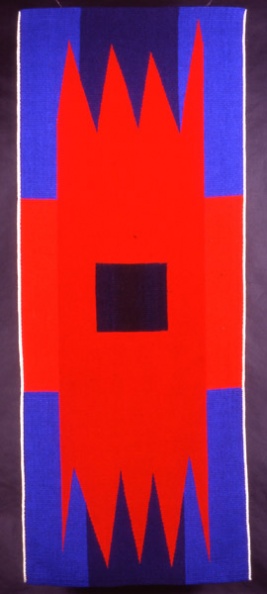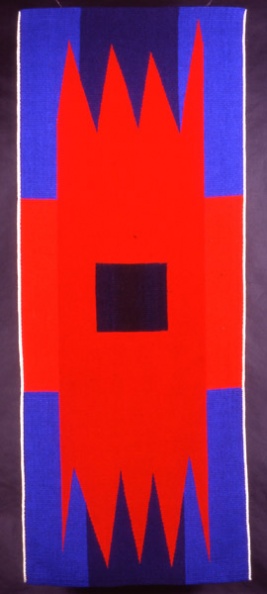
Pattern and Overshot Weft
My pattern is apparently formally called “Primrose in Diamonds” and it was made (designed or woven we wonder?) for Mariss Cottrell, 1813 by Weaver Rose, his No. 125. Found on page 146 in Davison, as suggested by Barbie in one of her samples handed around a few months ago.
I’d love to know what yarns everyone is handing around, now that most of them have been swapped, and we’re getting warped.
Mine is the rusty “Cinnamon” in Cascade Heritage 150, a nice superwash, colorfasst sock yarn that fit the bill for wpi and squishiness; I’m feeling I’ll have far greater success with this than the cotton I was messing about with last year for table linens. I get it now that-and-why they say wool for the overshot supplemental weft in an overshot pattern; the doubled cotton I tried was not any kind of squishy. Anyone who’d like to wince at a sample of less than skillful overshot fiber planning, I have one—they’re just fine as what they are, really, I just don’t *love* them.
This: I have a good feeling about.
What are your wefts?
-Ru
July program field trip to Stanford July 19th
Blacksheep Weavers’ Guild will be meeting on Stanford campus on Thursday, July 19th, to see several works of art. For those who would like to meet for supper, we will meet at 6 pm at Coupa Cafe by the Green Library:
You can see the menu and even order ahead of time here:
http://www.coupacafe.com/locations/stanford-green-library/
At 7 pm we will meet at the Green Library, 557 Escondido Mall, at the entrance by the Red Fountain, just off of Galvez, to see a tapestry called “Wordscapes” at the Green Library woven by famed Swedish weaver, Helena Hernmarck. PLEASE BRING A PHOTO ID!
After we visit the Green Library, we will go to the new Knight Business School to look at two outdoor exhibits by artist Peter Wegner, which have been put up recently at the (grand) new School of Business, by a man named Peter Wegner, one of which could also be called a wordscape.
Coverlet Project: The Nuts and Bolts
Who is weaving what?
(exchange yarn added Sep. 10th)
U. D. – Wandering Vine (aka Snail Trail, Cats Paw); Yarn: Teal, wool
R. T. – Primrose Diamonds; Yarn: Cinnamon, Cascade Heritage 150
K. D. – Johann Schleelein’s No. 125; Yarn: Blue/Purple
T. G. – Charity Beck; Yarn: Teal
C. V. – Sun, Moon and Stars
C. S. – Finnish Diamond: Yarn: Light Blue, cotton
A. M. – Bertha Gray #84; Yarn: Teal, handspun wool (single)
L. C. – Whig Rose; Yarn: Jade Green, wool
B. P. – Blooming Leaf; Yarn: Natural, handspun wool
J. P. – Star of Bethlehem; Yarn: Olive Green, wool
K. L. – ?; Yarn: Red
We have 11 weavers. This means that for a 12 square coverlet, one square will need to be repeated. For a 3 square by 4 square coverlet, the weaver would end up weaving 3 squares in her own weft: one for the guild quilt and two for her own coverlet.
What are the warp details?
8/2 cotton, unmercerized Valley Cotton from WEBS (yarn.com) in natural
288 total ends
18 e.p.i.
16″ total sleyed width
18″ of warp allowed per square
36″ loom waste allowance
So a warp for 13 squares (12 for a 3×4 coverlet plus one for the guild) would be 7.5 yards long.
What are the weft details?
The tabby weft (the plain weave weft picks between each pattern weft pick) is the same 8/2 cotton as the warp.
Weft yarn choice is up to the weaver. Each pattern weft pick needs to be fat enough to spread out and cover the tabby wefts on either side. But it also needs to be squishy enough to fit in the spaces between the tabby picks and still allow the tabby weft to be packed square with the warp, at 18 per inch. So an ideal weft would be something that can cover an inch with 18 wraps but then squish down to about half an inch. This works out to something between fingering and sport weight, I believe, depending on how hard the yarn is. The variation between the different chosen wefts provides a lot of the educational aspect of this project.
144-150 yards of pattern weft per square. For each square, the number of weft picks should equal the number of warp ends, which is 288. For ease in calculation, allow a generous 18″ (1/2 yard) per pick, which results in 144 yards each of tabby weft and pattern weft per square. Rounding up to 150 yards allows a comfortable margin.
For a 13 squares, this adds up to at total of about 1,950 yards of pattern weft.
Coverlet Project: Overview
What is it?
In the fall of 2011, members of the Black Sheep Handweavers Guild decided to undertake a cooperative friendship coverlet project. In the end, each weaver will end up with an overshot coverlet in the yarn of her choice. It will be made up of many squares. Each square will be woven by a different weaver, using a different overshot pattern. It is both a sampler and a memento of friendship.
The squares will all share a common background and tabby weft of unmercerized 8/2 Valley Cotton from WEBS in a natural, off white color. The pattern weft will be the choice of each weaver. Some will buy a yarn that they like. Others will spin their yarn.
Why overshot?
Overshot was chosen for several reasons. It gives excellent dimensional stability, since there are the same warp type threads running in both the warp and weft directions. It also offers a wide range of patterns. There are many traditional patterns available in overshot that reflect its prominence as a Colonial American art form. There are also modern versions. And, truth be told, any twill pattern can be converted to overshot by running alternating plain weave picks between the pattern weft picks. An inch of plain tabby weave is woven between each square to provide space for lines of stabilizing machine stitching.
How do the squares become a coverlet?
Once the squares are all woven, the participants will gather with the collection of squares that they have each woven in all the different weft colors. The long strips of many squares of different colors will be cut apart in between the lines of machine stitching. The squares will then be exchanged with the other weavers until each weaver has all of her own weft yarn back.
Each weaver will then assemble her coverlet from the squares she has gathered from the other weavers who wove with her chosen weft. Some may chose to sew them directly side by side. Some may insert fabric between the squares. Others may crochet a border around each square before sewing or crocheting them together. Some form of material between the squares helps adjust for possible differences in size and squareness.
Each weaver has a different pattern and a different weaving style. Even though every effort is made to avoid pulling in, squares may come out different widths. Some patterns may lead to more draw in than others. Each weaver also has to adjust to a different weft for each square. This presents challenges as well. The beat that makes a perfect square in one weft may be a bit too hard or too soft for the next one. Checking pick counts can help a lot, but some variation in dimension is to be expected, regardless.
The guild coverlet
Each weaver in this project will also be weaving one extra square in her own yarn to donate to the guild. These squares will be connected by a number of volunteers into a single coverlet. The guild coverlet will reflect both the pattern and yarn color choices of the participants. It will be auctioned or raffled off at a guild meeting or event.
The wrap up
This project fits the guild to a tee. It fosters cooperation, encourages memories, and provides a crash course in many nuances of overshot weaving. After a number of months full of finding or spinning weft, dressing looms, weaving a wide range of wefts and doing the inevitable head scratching and deep breathing, we will each emerge with a memento of some wonderful weaving friendships. Weave on!
Introduction to Katazome Workshop
We are pleased to announce a workshop with Karen Miller on the art of Japanese Stencil Dyeing.
Dates: July 14-15, 2012
Time: 9AM – 5PM both days
Cost: approx. $175 + 35 materials fee / student (depends on number of students)
Location: Amazing Yarns, 2559 Woodland Place, Redwood City, CA
Japanese fabrics have been made for centuries using intricate paper stencils and a resist paste made of rice flour. Authentic Japanese fabrics using this technique are very expensive and almost unobtainable in this country. You will learn how to make these lovely fabrics yourselves, dyeing them with indigo and/or colored dyes. On the first day we will carve two stencils from Japanese paper, and apply silk mesh to strengthen them. While the stencil is drying we will make the resist paste. We will use some of my stencils to apply paste to fabric so it will have time to dry overnight. The second day we will learn how to use a variety of traditional pigments, to produce multicolored images on silk or linen. Students will use their own stencils to paste silk scarves to dye and take home.
Please contact Ann McDonough for more information or to sign up for the workshop.
A $100 deposit is required to hold your place in the workshop.
April 19th program: Polly Barton, Silk Weaver
We welcome acclaimed silk weaver Polly Barton to our April 19th guild meeting. Her website is http://www.pollybarton.com/
Her talk will be about the evolution of her work, the artists who have inspired her, and techniques she uses in her work.
Her work is in the Sourcing the Museum show which opens this coming March 23rd at the Textile Museum.
She is also featured on the virtual tour of the National Museum of Women in the Arts. at the Textile Museum in Washington, DC. http://www.textilemuseum.

May 17th: Mary Zicafoose Tapestries
We welcome renowned fiber artist Mary Zicafoose to our May 17th meeting.
For over two decades, international textile artist Mary Zicafoose has been creating tapestries and rugs that are as rich in color as they are in symbolic content. Her work is included in private and public collections that span the globe, including U.S. Embassies on three continents. The artist’ practice and processes reflect superb craftsmanship as well as her ability to articulate a brilliant contemporary vernacular based on color. Her woven pieces blend cultural icons, images and symbols with an unabashed hand, creating powerful visual statements in fiber. Zicafoose maintains a one-woman fiber studio in Omaha, NE where she lives with her family.
June Raffle and Sale
Our June meeting, Thursday, June 20th will be the annual raffle and sale. Now is the time to start looking in your stashes for wonderful items that someone else is coveting. This year we also welcome hand-woven, knitted and spun items.
Black Sheep Exhibits at the Redwood City Library
Here are links to some past exhibits at the Redwood City and Menlo Park Libraries (pictures by Chuck Thompson):
2014 Redwood City Library exhibit
2013 Redwood City Library exhibit
2013 Menlo Park Library exhibit
2012 Redwood City Library Exhibit

